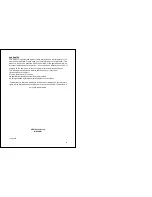
2
power tool will increase the risk of electric shock.
d)
Do not abuse the cord. Never use the cord for carrying, pulling or
unplugging the power tool. Keep cord away from heat, oil, sharp edges or
moving parts.
Damaged or entangled cords increase the risk of electric shock.
e)
When operating a power tool outdoors, use an extension cord suitable
for outdoor use.
Use of a cord suitable for outdoor use reduces the risk of
electric shock.
3)
Personal safety
a)
Stay alert, watch what you are doing and use common sense when
operating a power tool. Do not use a power tool while you are tired or
under the influence of drugs, alcohol or medication.
A moment of inattention
while operating power tools may result in serious personal injury.
b)
Use safety equipment. Always wear eye protection.
Safety equipment
such as dust mask, non-skid safety shoes, hard hat, or hearing protection used
for appropriate conditions will reduce personal injuries.
c)
Avoid accidental starting. Ensure the switch is in the off position before
plugging in.
Carrying power tools with your finger on the switch or plugging in
power tools that have the switch on invites accidents.
d)
Remove any adjusting key or wrench before turning the power tool on.
A wrench or a key left attached to a rotating part of the power tool may result in
personal injury.
e)
Do not overreach. Keep proper footing and balance at all times.
This
enables better control of the power tool in unexpected situations.
f)
Dress properly. Do not wear loose clothing or jewellery. Keep your hair,
clothing and gloves away from moving parts.
Loose clothes, jewellery or
long hair can be caught in moving parts.
g)
If devices are provided for the connection of dust extraction and
collection facilities, ensure these are connected and properly used.
Use of
these devices can reduce dust related hazards
.
4)
Power tool use and care
a)
Do not force the power tool. Use the correct power tool for your
application.
The correct power tool will do the job better and safer at the rate
for which it was designed.
b)
Do not use the power tool if the switch does not turn it on and off.
Any
power tool that cannot be controlled with the switch is dangerous and must be
repaired.
c)
Disconnect the plug from the power source before making any
adjustments, changing accessories, or storing power tools.
Such
preventive safety measures reduce the risk of starting the power tool
accidentally.
d)
Store idle power tools out of the reach of children and do not allow
persons unfamiliar with the power tool or these instructions to operate the
power tool.
Power tools are dangerous in the hands of untrained users.
3
e)
Maintain power tools. Check for misalignment or binding of moving
parts, breakage of parts and any other condition that may affect the power
tools operation. If damaged, have the power tool repaired before use.
Many
accidents are caused by poorly maintained power tools.
f)
Keep cutting tools sharp and clean.
Properly maintained cutting tools with
sharp cutting edges are less likely to bind and are easier to control.
g)
Use the power tool, accessories and tool bits etc., in accordance with
these instructions and in the manner intended for the particular type of
power tool, taking into account the working conditions and the work to be
performed.
Use of the power tool for operations different from intended could
result in a hazardous situation.
5)
Service
a)
Have your power tool serviced by a qualified repair person using only
identical replacement parts.
This will ensure that the safety of the power tool
is maintained.
WARNING:
•
The use of an accessory or attachment, other than those
recommended in this Instruction Manual, may present a risk of
personal injury.
•
The tool must be used only for its prescribed purpose. Any use other
than those mentioned in this Manual will be considered a case of
misuse. The user and not the manufacturer shall be liable for any
damage or injury resulting from such cases of misuse.
ADDITIONAL SAFETY RULES FOR JIGSAWS
z
Ensure that the lighting is adequate.
z
Do not use the saw unless the guards are in place
z
Keep the shoe flat on the work piece.
z
Do not put pressure on the saw, such that it slows the motor down. Allow
the saw blade to cut without pressure. You will get better results and you
will be taking better care of your tool.
z
Keep the area free of tripping hazards.
z
Only use blades in good condition.
z
Before cutting, check that there is sufficient clearance for the blade under
the work piece.
z
Do not touch the blade after operation. It will be very hot.
z
Keep your hands away from under the work piece.
z
Never use your hands to remove sawdust, chips or waste close to the
blade.
z
Rags, cloths, cord, string and the like should never be left around the work
area.
z
Avoid cutting nails. Inspect the work piece and remove all nails and other
foreign objects before beginning sawing.






